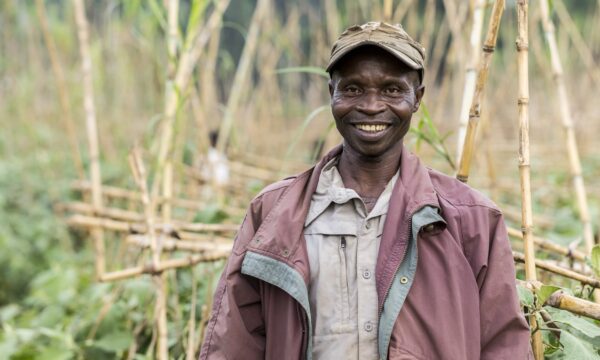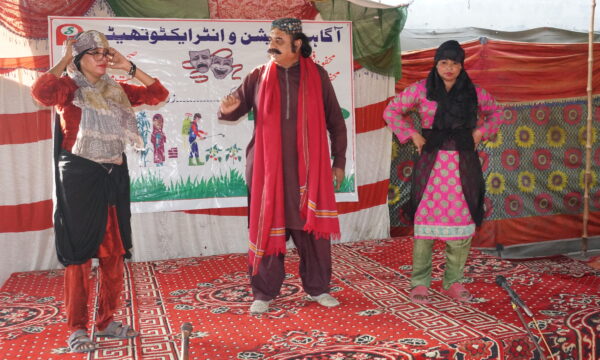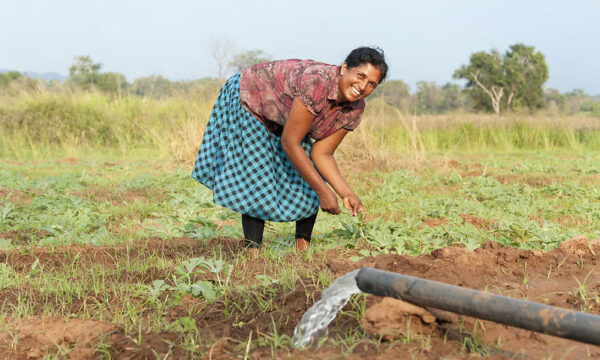
Women play a critical and potentially transformative role in agricultural growth in developing countries, but they face persistent obstacles and economic contraints which limit their full inclusion in agriculture. The FAO suggest that closing the gender gap in access to productive resources could increase agricultural output in the developing world by 2.5-4%, reducing the number of undernourished people by 12-17%. Women in Sub-Saharan Africa and South Asia produce more than half of all the food grown worldwide. Empowering women in agriculture is fundamental to achieving the global goals.
Women in Sub-Saharan Africa and South Asia produce more than half of all the food grown worldwide.
Opportunities for women are limited by the societal roles they are expected to fulfil. Women in agriculture consistently under report the amount of work they do, often not self-identifying as farmers despite being in charge of kitchen gardens and producing subsistence crops for the family, or even when they undertake the planting, weeding, tending, and harvesting of crops. In general, women have three main areas of work; the ‘women’s triple role’: productive (income generating), reproductive (keeping a home), and community (organising ceremonies, celebrations, funerals…). Women are not only looking after families and doing the housework, but also carrying out manual labour – they are carers and workers.

Today, 76% of the world’s extreme poor live in rural areas, and 70% of the world’s poor are women. So how do we reach these rural women? While many progammes are “gender intentional” – investing in reducing gender gaps and improving the condition of women and girls; the real game-changers are those which are “gender transformative” – investing in transforming gender relations and increasing empowerment. It is vital to understand the structures and systems that determine women’s position in society in order to make meaningful change.
A recent study from open access journal, Cogent Food & Agriculture, highlights the need to acknowledge the heterogeneity of women and design multidimensional programmes that can help more women gain full access to resources. This is intersectionality, recognising that women in agriculture have a multitude of overlapping identities, and therefore a blanket, one-size-fits-all strategy cannot be applied to be truly successful or inclusive. The study looks at gender integration within the scaling up of a successful pilot project and specifically draws on evaluations undertaken by researchers of the Scaling-up of Pulse Innovation for Food and Nutrition Security (SPIFoNS) Project, implemented in Southern Ethiopia.
Intersectionality means recognising that women in agriculture have a multitude of overlapping identities
The SPIFoNS Project aimed to ensure that women were also beneficiaries of its agricultural advantages. For example, the project provided women with agricultural training such as sowing techniques and the appropriate use of fertilizers, education on the nutritional benefits of their crop, and even delivered gender workshops where men and women farmers openly discussed gender issues to bring about better understanding and recognition of women’s roles in agriculture.

While these were strong gender strategies, the result of this approach showed that only single women (divorced/separated/widowed) benefited. Women reported that by being more involved in their crop production they became economically empowered which led to a reduction in their vulnerability and the enhancement of their social mobility. The majority of single women heads of households reported that their role in society had increased in value and that they felt important and were respected by others.
However, the research discovered that married women did not benefit in the same way from the gender strategies. Since married women’s access to information is predominantly through their husbands, their links to networks and therefore access to agricultural extension workers is much more limited. It emerged that since men’s roles in agriculture are so well-established, married women’s contribution continued to go undervalued.
 Another aspect which came to light were the differences in how men and women control income. While many men felt that women could not be trusted to properly measure large quantities of crop to sell, women often stated that they do not get distracted by socialising and are actually much more accurate when going to market. Similar results from other studies also show that empowerment leads to more secure households.
Another aspect which came to light were the differences in how men and women control income. While many men felt that women could not be trusted to properly measure large quantities of crop to sell, women often stated that they do not get distracted by socialising and are actually much more accurate when going to market. Similar results from other studies also show that empowerment leads to more secure households.
As the paper summarises, “while accommodating gender may help to highlight positive outcomes and short-term gender gains to satisfy funders, such an approach in the long-term will not contribute to reducing culturally entrenched gender hierarchy and resultant inequality.” It is important that organisations regularly ask communities whether their needs are being met so that in the long-term, progammes can be more adaptable and transformative.
It is important that […] progammes can be more adaptable and transformative.
In order to really challenge patriarchy and bring about gender parity, the bigger task comes in deconstructing ideologies and changing entrenched perceptions. Of course women and girls have the capacity and ability (they always have!), but the challenges faced are complex, shaped by the intersectional systems of society, and this intersectionality needs our full attention. With the ever increasing rise of female empowerment movements, the time really is now.
This International Women’s Day, the gender disparity for women in agriculture is being highlighted through the #FilltheGap campaign.
Discover how Plantwise is working to address gender →
3 Comments
Leave a Reply
Related News & Blogs
Empowering women farmers through Gender Technical Working Groups
How PlantwisePlus is championing gender equality in agriculture through GTWGs Gender Technical Working Groups play a vital role in advancing equality in rural communities. Women in villages often have less access to knowledge, resources and power…
23 May 2025





[…] to families in the developing world, and is a role that is most often taken up by women and girls. Women often do not self-identify as farmers despite being in charge of kitchen gardens, or even when they undertake the planting, weeding, […]
[…] to families in the developing world, and is a role that is most often taken up by women and girls. Women often do not self-identify as farmers despite being in charge of kitchen gardens, or even when they undertake the planting, weeding, […]
good info. thanks